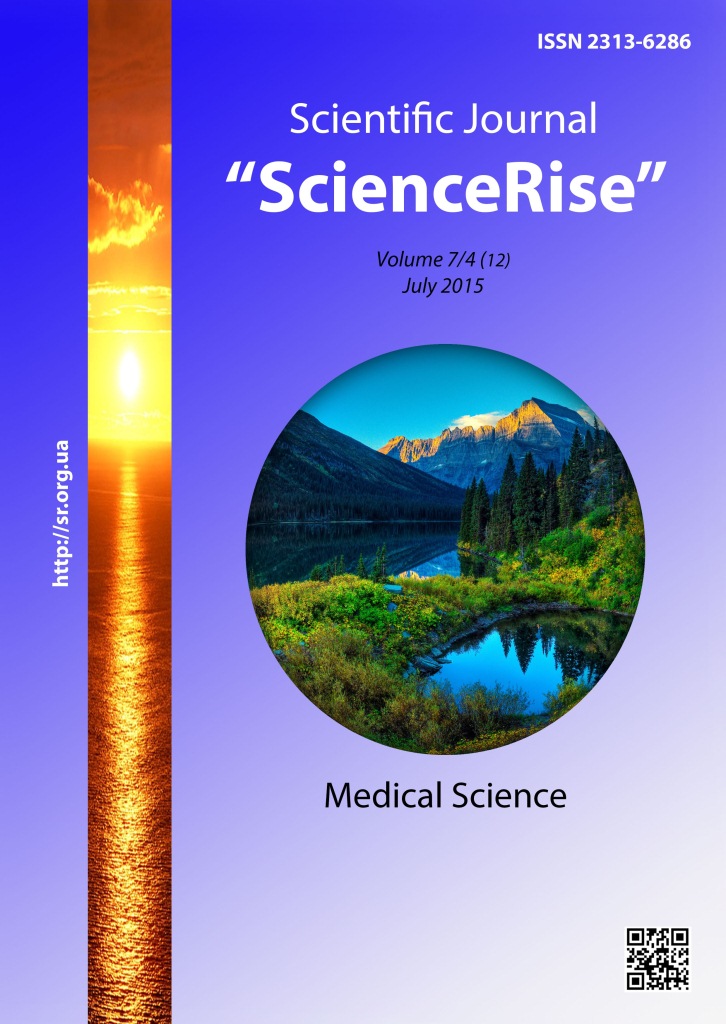Peculiarities of surgical treatment of acute form of congenital hypertrophic pyloric stenosis
DOI:
https://doi.org/10.15587/2313-8416.2015.47365Keywords:
congenital hypertrophic pyloric stenosis, children, double pyloromyotomy, hypertrophy of the muscular coat of pylorus.Abstract
Aim of research: to study an efficiency of the double pyloromyotomy at congenital pyloric stenosis in children and its impact on regress of hypertrophy of pylorus in postoperative period.
Material and methods of research: there was carried out an analysis of 157 patients with an acute form of congenital hypertrophic pyloric stenosis (CHPS) that characterizes with a sudden beginning of disease, predominance of “fountain” vomiting over regurgitation, fast growth of homeostasis dysfunctions and decrease of the body weight. All children were separated in 2 groups statistically homogenous on sex, age and prescription of disease. The first group of examination (children who underwent the double pyloromyotomy) included 65 boys. The second (control) group included 92 male children who underwent the standard pyloromyotomy according to Frede-Weber-Ramstedt.
The ultrasound examination of pylorus in dynamics with detection of its volume was carried out in both groups.
Results. The results of intraoperative assessment of the state of injured pylorus indicate an existence of two macroscopic variants of it: “rigid pyloric olive” that was registered in 82 % of children of the first group and the “soft pyloric olive” – in 79% of patients of the control group. “Rigid olive” characterized with hard “cartilaginoid” consistency of fusiform thickened pylorus of the whitish color. “Soft olive” had the dense elastic consistency and the pink-pale color.
The regress of “pyloric olive” in all children took place on average during 67,92,2 (Mm) days. But in children of the second group medium terms of involution of hypertrophy of pylorus were 75,74,1 (Mm) days. In patients who underwent the double pyloromyotomy these terms were reliably (р0,05) lower and varied within 41,71,5 (Mm) days.
Conclusions. Involution of hypertrophy of pyloric end after the surgical treatment of CHPS occurs gradually and depends on adequacy of regeneration of the patency of pylorus. The double pyloromyotomy at an acute form of CHPS not only improve the patency of the pyloric segment of stomach during an early postoperative period but also accelerates the full regress of hypertrophy of pylorus from 75,74,1 (Мм) to 41,71,5 (Мм) days.
References
Spahi, O. V. (2012). Harakteristika koncentracii gastrina i somatostatina u detej s vrozhdennym gipertroficheskim pilorostenozom do i poste vosstanovlenija prohodimosti zheludka. Neonatologіja, hіrurgіja ta perinatal'na medicina, 2 (1), 42–45.
Feng, Z., Nie, Y., Zhang, Y., Li, Q., Xia, H., Gong, S., Huang, H. (2014). The clinical features of infantile hypertrophic pyloric stenosis in Chinese Han population: analysis from 1998 to 2010. PLoS One, 19–29.
Ayaz, Ü. Y., Döğen, M. E., Dilli, A., Ayaz, S., Api, A. (2015). The use of ultrasonography in infantile hypertrophic pyloric stenosis: does the patient's age and weight affect pyloric size and pyloric ratio? Med Ultrason, 17 (1), 28–33.
Dassinger, M., Fuchs, G. J. (2014). Infantile Hypertrophic Pyloric Stenosis. Journal of Pediatric Gastroenterology and Nutrition, 58 (5), 545. doi: 10.1097/mpg.0000000000000324
Murtagh, K., Perry, P., Corlett, M., Fraser, I. (1992). Infantile Hypertrophic Pyloric Stenosis. Digestive Diseases, 10 (4), 190–198. doi: 10.1159/000171357
Welsh, C., Shifrin,Y., Pan, J., Belik, J. (2014). Infantile hypertrophic pyloric stenosis (IHPS): a study of its pathophysiology utilizing the newborn hph-1 mouse model of the disease. Am J Physiol Gastrointest Liver Physiol, 15, 198–206.
Spahi, O. V., Tokarev, B. G., Ljaturinskaja, O. V., Zaporozhchenko, A. G. (2004). Neposredstvennye i otdalennye rezul'taty lechenija vrozhdennogo pilorostenoza u detej. Hіrurgіja ditjachogo vіku, 3, 63–69.
Hernanz-Schulman, M., Neblett, W. W., Polk, D. B., Johnson, J. E. (1998). Hypertrophied pyloric mucosa in patients with hypertrophic pyloric stenosis. Pediatric Radiology, 28 (11), 901–901. doi: 10.1007/s002470050495
Hernanz-Schulman, M. (2003). Infantile Hypertrophic Pyloric Stenosis1. Radiology, 227 (2), 319–331. doi: 10.1148/radiol.2272011329
Solovjov, A. Je., Spahi, O. V., Ljaturyns'ka, O. V., Makarova, M. O. (2004). Sposib likuvannja vrodzhenogo gipertrofichnogo pilorostenozu: pat. № 68753 A Ukrai'na, MPK A61V17/00. A. Zajavnyk ta patentovlasnyk Zaporiz'kyj derzhavnyj medychnyj universytet. – № 2003109437; zajavl. 20.10.2003; opubl.16.08.2004. Promyslova vlasnist', 8 (1), 4.37.
Downloads
Published
Issue
Section
License
Copyright (c) 2015 Олег Владимирович Спахи

This work is licensed under a Creative Commons Attribution 4.0 International License.
Our journal abides by the Creative Commons CC BY copyright rights and permissions for open access journals.
Authors, who are published in this journal, agree to the following conditions:
1. The authors reserve the right to authorship of the work and pass the first publication right of this work to the journal under the terms of a Creative Commons CC BY, which allows others to freely distribute the published research with the obligatory reference to the authors of the original work and the first publication of the work in this journal.
2. The authors have the right to conclude separate supplement agreements that relate to non-exclusive work distribution in the form in which it has been published by the journal (for example, to upload the work to the online storage of the journal or publish it as part of a monograph), provided that the reference to the first publication of the work in this journal is included.

